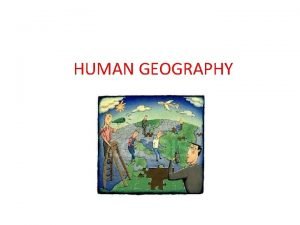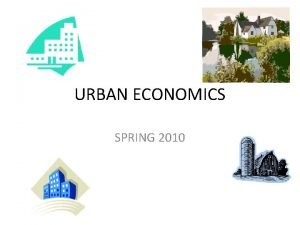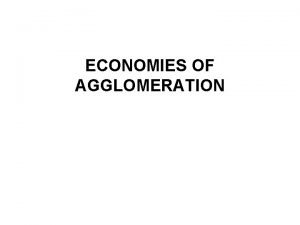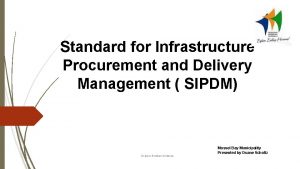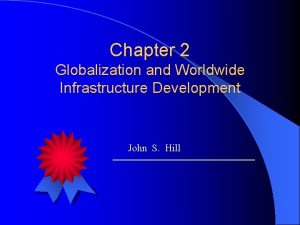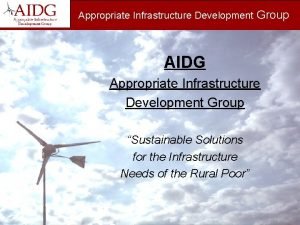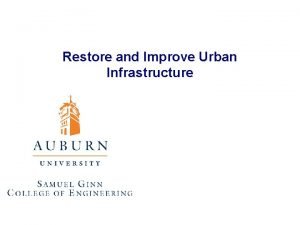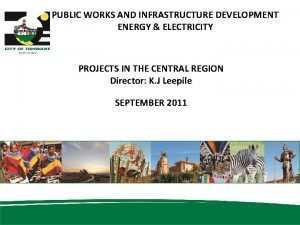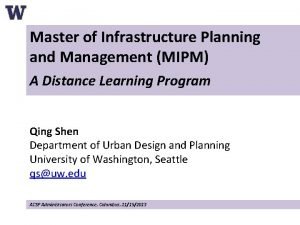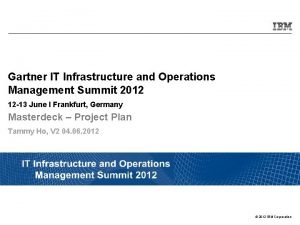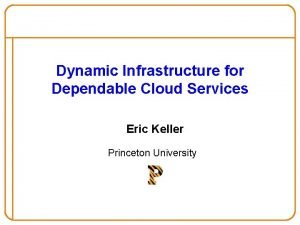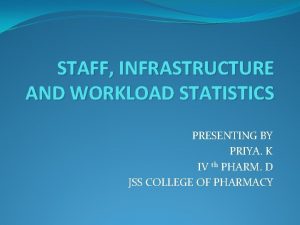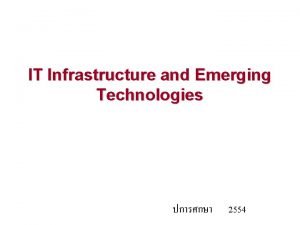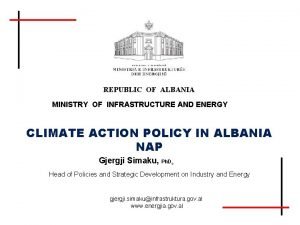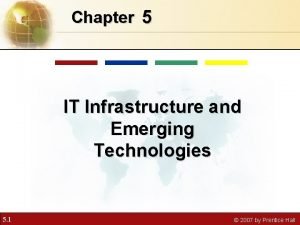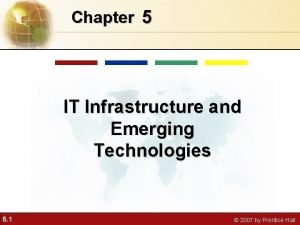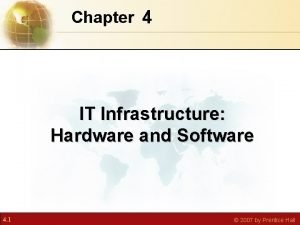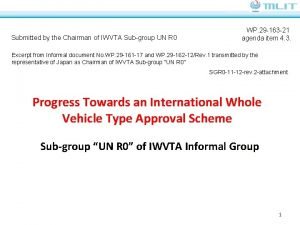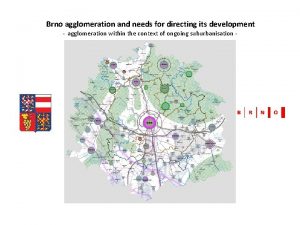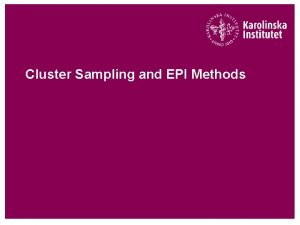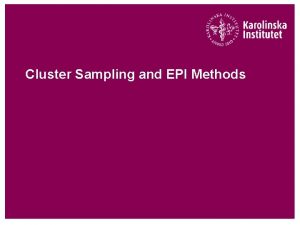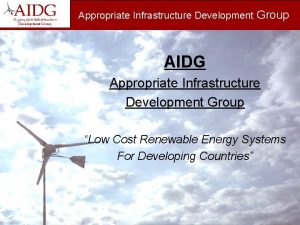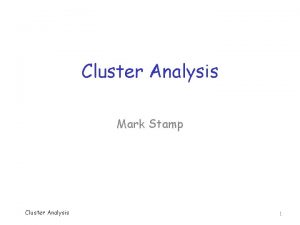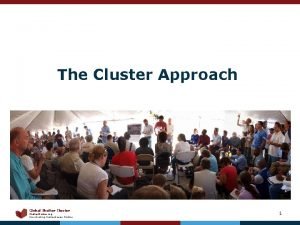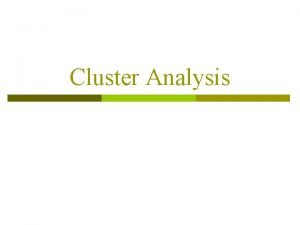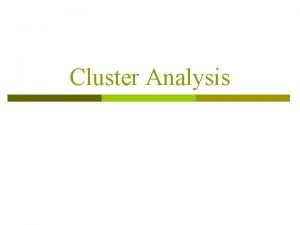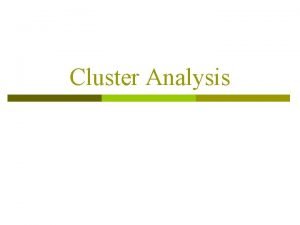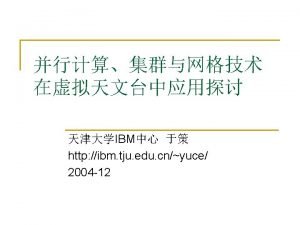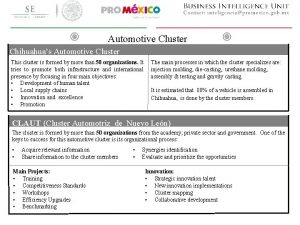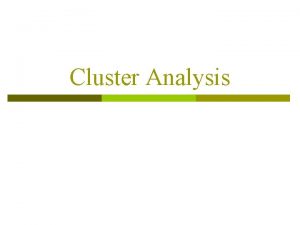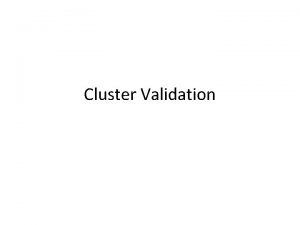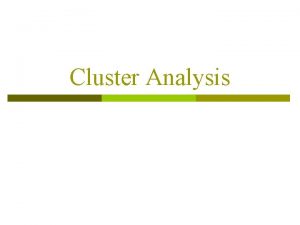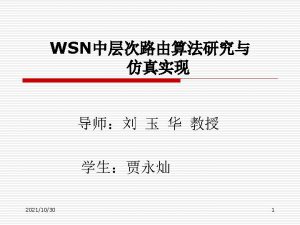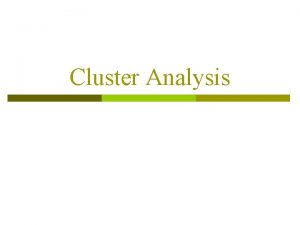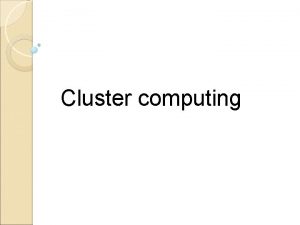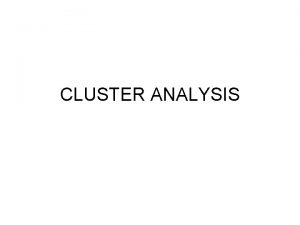Infrastructure Agglomeration Cluster Development and Cluster Policy Sayed






































- Slides: 38

Infrastructure, Agglomeration, Cluster Development and Cluster Policy Sayed H. Saghaian (Mehdi), Associate Professor University of Kentucky Lexington, Kentucky

Economic Geography What happens where? Why do firms and people tend to concentrate in a few locations ? What explains the variety of economic activities and land uses in a region? What are the economic diversification prospects for low-population places that are costly to get to and from? Why some regions achieve significantly higher growth rates than others?

Economic Geography Spatial Economics Understanding the role of distance Theory of Spatial Equilibrium Production Location Theory Land Economics Study of land use and value Regional Economics Sub-national economics Rural Economics Urban Economics

Foundation Stones Three foundation stones: an understanding of spatial and regional economic problems built on three facts of life: Natural resource advantages, Economies of concentration, and Costs of transportation and communication. A fundamental view: the importance of trade-offs among: Scale, Transport costs, and Endowments in explaining the economics of establishment location.

Urban-Rural The important role of local public goods and amenities to explain household and establishment location choices. The emergence of auto transport by mid– twentieth century made commuting to urban employment the mode to engage with urban economies. Increased accessibility to urban markets key factor to prosperity of regions.

Urban-Rural Urban growth cause of rural-brain-drain The pull effect of the higher urban returns to human capital Highest skilled will leave Exurban sprawl fuel adjacent rural growth Job growth complementary to population growth through increased commuting. 60% of local non-metro job growth is due to commuting, 30% through migration.

Urban Centers Urban centers and spatial concentration of production provide: Product variety: Intermediate inputs for firms Final goods to consumers Monopolistic competition (more firms) Average cost pricing Higher profits

Agglomeration It is geographic concentration of related economic activities. The agglomeration of related economic activity is a central feature of economic geography. Agglomeration arises from interdependencies across complementary economic activities that give rise to increasing returns. Trade-Offs: Ø Either enjoying agglomeration economies of scale, Ø or avoiding transportation costs wrt spatially immobile resources.

Agglomeration Two potential types of agglomerating forces: localization (increasing returns to activities within a single industry) and urbanization (increasing returns to diversity at the overall regional level). Agglomeration may arise from: specialization of a region in a particular industry where firms share common inputs or knowledge (so called localization economies). exploiting the overall diversity of industries in an entire regional economy (so called urbanization economies).

Agglomeration At least three distinct drivers of agglomeration: input-output linkages, labor market pooling, and knowledge spillovers. Additional agglomeration drivers: local demand, specialized institutions and the structure of regional business and social networks

Agglomeration In a given location, limitations on resources can result in diminishing returns. This can lead to convergence in economic activity (employment, income, productivity) across regions over time Each of those mechanisms is associated with cost or productivity advantages that result in increasing returns to geographically proximate economic activity. Free trade remove barriers to agglomeration and foster growth of clusters. Clustering of economic activity is wisely recognized as resulting in economies of agglomeration.

What is Competitiveness? Competitiveness is the productivity with which a nation uses its human, capital, and natural resources Productivity sets the standard of living Productivity growth sets sustainable economic growth Productivity and prosperity depends on how a nation competes, not what industries it competes in Relentless innovation necessary to drive productivity growth and enable standard of living to rise Technology, products, and organizational methods

Competitiveness & Diamond Framework Many things matter for competitiveness: Successful economic development is a process of successive upgrading, in which the business environment improves to enable increasingly sophisticated ways of competing. Porter Diamond Model for Competitive Advantage The Diamond Framework has four dimensions: Context for Firm Strategy and Rivalry Factor (Input) Conditions Demand Conditions Related and Supporting Industries

Diamond Framework

Diamond Framework

Diamond Framework

Context for Firm Strategy and Rivalry A local context and rules that encourage productivity incentives for capital investments and intellectual property protection Incentive systems based on merit Open and vigorous local competition, especially among locally based rivals

Factor (Input) Conditions Availability of high quality, specialized inputs available to firms: Human resources Capital resources Physical infrastructure Administrative infrastructure (e. g. registration, permits) Information infrastructure (e. g. economic data, corporate disclosure) Scientific and technological infrastructure Natural resources

Demand Conditions More sophisticated and demanding local customer(s) Local customer needs that anticipate those elsewhere Unusual local demand in specialized segments that can be served nationally and globally

Related and Supporting Industries Access to capable, locally based suppliers and firms in related fields Presence of clusters instead of isolated industries

What is a Cluster? Michael Porter defines clusters as “geographically proximate groups of interconnected companies and associated institutions in a particular field, linked by commonalities and complementarities”. Clusters have become the focal point of many new policy initiatives globally in the last few years. The goal is to become the most competitive and dynamic knowledge based economy. Clusters are a leverage point for action, not just a description of economic reality. A way to realize location-based complementarities.

Anatomy of a Cluster Federal Agencies Labor Organizations Sources of Capital Support Industries Workforce Development & Training Driver Industries: Suppliers: Local & State Gov’t Customers: Public Infrastructure Universities Nonprofits Community & Technical Colleges

Cluster Characteristics Firms and institutions in a cluster share four critical characteristics: Proximity; they need to be sufficiently close in space to allow positive spill-overs and sharing of common resources to occur Linkages; their activities need to share a common goal, for them to be able to benefit from proximity and interaction Interactions; for positive cluster effects to occur some level of active interaction has to be present Critical mass; needs to be sufficient number of participants for interactions to have a meaningful impact on performance Understanding these four dimensions is more important than defining specific benchmarks for firms and institutions to be called a cluster.

Clusters and Innovation Clusters allow to be more productive and innovative. Clusters provide a particularly fertile ground for innovations. Clusters reduce barriers to entry for new business creation relative to other locations. Innovation occurs in non-sequential interactions of different universities, research institutions, and companies. Different from traditional model where R&D centers turned universities’ basic research into applied products and processes. Clusters of Innovation: locations face to compete on innovation and productivity.

Roles of Private and Public Sectors Cluster initiatives an opportunity to redefine the roles of the private and public sector in economic policy. Economists focus on clusters as geographic concentration of interconnected companies and institutions in a particular field. Clusters offer a crucial opportunity to take the necessary steps for modernizing economic policies.

Cluster and Macro Policy The turn to cluster policy is a shift in priorities from macro to microeconomic issues. Monetary and fiscal policies are increasingly well understood. But macroeconomic progress turned out to be only necessary, not sufficient to achieve higher prosperity. Targeted microeconomic efforts in a new partnership with private sector, universities, and other institutions is required to translate the macroeconomic achievements into real productive improvements.

Cluster Development Efforts for cluster development and for regional economic development need to be better integrated. Cluster development should not aim to create clusters, but to activate them. Activating an existing base of companies and institutions to jointly upgrade their cluster is more effective than creating clusters from scratch. The state of cluster development is a measure of active policies to strengthen clusters, and the overall cluster rank is a measure of necessary ingredients for clusters.

Cluster Policy Clusters are a useful way to organize efforts and launch effective action initiatives. Need to strengthen home clusters to exploit their roles. Cluster Policy: provide budget for cluster development, and use clusters to set policy priorities. Providing better data on clusters, convening joint public-private research groups for clusters, and supporting regional cluster initiatives are the key roles.

Cluster Mapping Employing cluster approach to regional growth policy is crucial. regional employment patterns in groups of industries could be defined as clusters. There is a need for a Cluster Mapping Project. cluster mapping: quantitatively identify and profile clusters. cluster mapping efforts could cover municipalities, counties, urban economies, or national economies. need to conduct and compile cluster case studies.

Policy and Practice Must Change Unprecedented challenges require innovative solutions for creating jobs and promoting regional prosperity. From Silos … … to Collaboration. Economic and Industry Policy: maintaining a robust economy in which innovative activity thrives and supporting industry development. Regional Policy: building competitive regions by developing skills and initiatives that boost local economic activity Education Policy: identifying skill shortages and training needs for re-skilling or up-skilling and investing in skill development programs. Science and technology policy: supporting collaborative research involving networks with industry and stimulating the commercialization of research.

Regional Clusters Implies bounded area characterized by inherent social, environmental, economic, and cultural assets Transcends sociopolitical boundaries Include both urban & rural

Regional Assets Five Key Components to Consider When Defining Unique Regional Assets: What you make, including your existing & prospective industry clusters What you do: your workforce skills & human capital base ECONOMIC BASE TALENT ENTREPRENEURSHIP INNOVATION & IDEAS Location, Infrastructure, Amenities, Factor Costs, Natural Resources The basic conditions defining the economic milieu of the region Your capacity to create companies wholly new or from existing firms Your capacity to innovate and generate new ideas

Regional Innovation Clusters Latin: To make new or renew The value-added commercialization of a new idea that produces new goods, services, and/or processes. The recombination of existing goods, services and processes that results in new or renewed goods, services, and/or processes. Because innovation can be widely applied it can occur in both emerging and traditional industries

Regional Innovation Clusters Presence of spatially proximate organizations that share active commercial interaction channels, specialized infrastructure, labor markets, and services. Share a common goal to maximize regional prosperity Link to trans-regional and global networks.

Regional Cluster Policy One of the first regions to apply cluster policy in its economic policy was the Basque country in Spain. In deep economic crisis of its steel and ship building, public and private sector leaders adopted the cluster approach to change their economic trajectory. A decade later, the region is one of the richest regions in Spain and has achieved a GDP per capita level equal to the EU average. Many countries employ clusters in their policy. For example, the Netherlands and Denmark.

Regional Clusters: Evidence Regional clusters: groups of closely related and complementary industries operating within a region. There is significant evidence for cluster-driven agglomeration. Industries participating in a strong cluster register higher employment and wage growth, number of establishments, and patenting. New regional industries emerge where there is a strong cluster environment. The presence of strong clusters enhances growth opportunities in other industries and clusters.

Regional Clusters: Surveys Most surveyed clusters are dominated by small or medium-sized companies. Most surveyed clusters serve global markets. R&D and advanced services available within a particular field in many clusters. Clusters tend to be young, growing, and among the national leaders in their fields. The Global Competitiveness Report provides comparative data on overall cluster strength for 75 countries.

Thank You!
 El sayed el ayouty & co
El sayed el ayouty & co Agglomeration vs aggregation
Agglomeration vs aggregation Stepek ap human geo
Stepek ap human geo Agglomération toulouse
Agglomération toulouse Spanishsault
Spanishsault Rimland theory ap human geography
Rimland theory ap human geography Agglomeration economies
Agglomeration economies Agglomeration economies
Agglomeration economies Paxos algorithm
Paxos algorithm Photo
Photo Sayed ahmad salehi
Sayed ahmad salehi Sayed iftekhar
Sayed iftekhar Sipdm0
Sipdm0 Development of infrastructure in globalization
Development of infrastructure in globalization Appropriate infrastructure development group
Appropriate infrastructure development group Policy development steps
Policy development steps Collection development policy
Collection development policy Ways to improve urban infrastructure
Ways to improve urban infrastructure Public works and infrastructure logo
Public works and infrastructure logo Azure_rm_resourcegroup
Azure_rm_resourcegroup National infrastructure simulation and analysis center
National infrastructure simulation and analysis center Mcse mobility
Mcse mobility Masters in infrastructure planning and management
Masters in infrastructure planning and management Computer hardware platforms in it infrastructure
Computer hardware platforms in it infrastructure Gartner portfolio management summit
Gartner portfolio management summit Cloud and dynamic infrastructure
Cloud and dynamic infrastructure It infrastructure and emerging technologies
It infrastructure and emerging technologies Workload statistics in hospital pharmacy slideshare
Workload statistics in hospital pharmacy slideshare It infrastructure and emerging technologies
It infrastructure and emerging technologies It infrastructure hardware and software
It infrastructure hardware and software Hardware and software infrastructure
Hardware and software infrastructure Chapter 5 it infrastructure and emerging technologies
Chapter 5 it infrastructure and emerging technologies Albania ministry of infrastructure and energy
Albania ministry of infrastructure and energy Chapter 5 it infrastructure and emerging technologies
Chapter 5 it infrastructure and emerging technologies Chapter 5 it infrastructure and emerging technologies
Chapter 5 it infrastructure and emerging technologies It infrastructure hardware and software
It infrastructure hardware and software Grid security infrastructure
Grid security infrastructure Ministry of land infrastructure transport and tourism
Ministry of land infrastructure transport and tourism Managing assets vs asset management
Managing assets vs asset management




